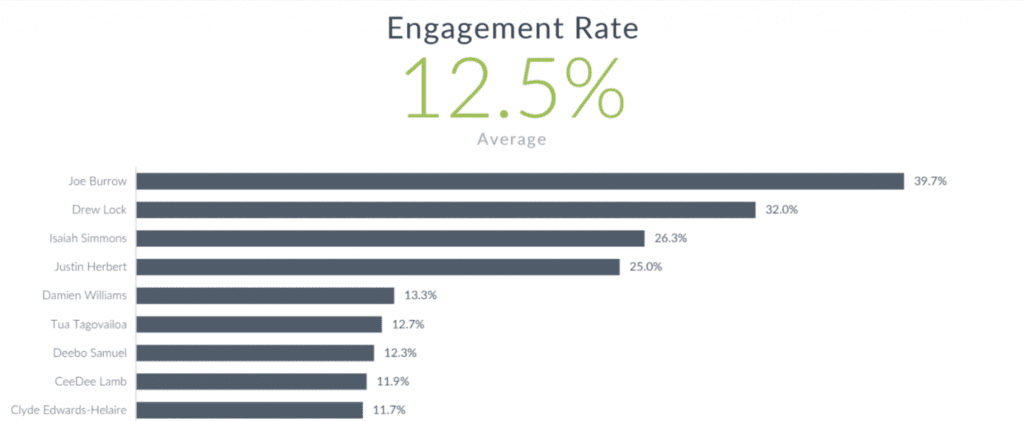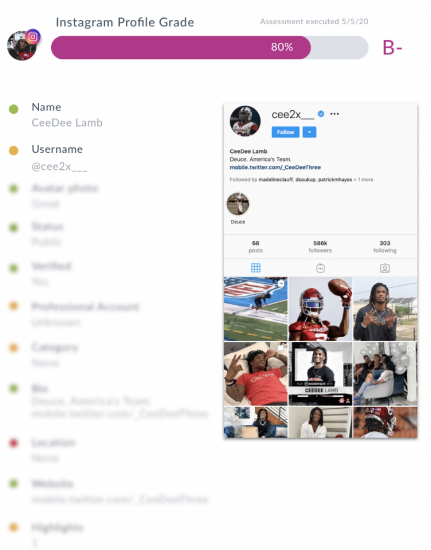Build your brand.
Be a storyteller.
Share great content.
These are all good pieces of advice student-athletes and recruits… but what do they really mean? In the era of name, image, and likeness rights in college sports, statements like these are on the right track, but offer little more than a generic reminder.
Today’s student-athletes and incoming recruits are social media natives. They’re often entering college with large, valuable audiences. Many already understand the need to develop their brand with frequent, consistent content on their channels of choice.
But to maximize the value of their name, image, and likeness, athletes need a roadmap. They need assessment and education resources that have been proven at the highest levels of sports.
Building a powerful personal brand is never one-size-fits-all. But to maximize earning potential, athlete social media profiles must be easy to find and fit the criteria of potential sponsors. While brand-building is personal, fine-tuning profiles and assessing performance can be systemic. Let’s dive in.
Build a powerful profile
“If you can’t be found, you can’t be followed.
A surefire way to turn away sponsors is to have a feed filled with inappropriate or harmful language.
Really, this applies to all users, not just athletes. Social media misfires have doomed job applicants, politicians, and of course, has derailed what should proud moments for far too many athletes.
This can all be avoided. The best avoidance is never tweeting that insensitive statement, but hey, we all make mistakes. Today, every athlete should go back and audit and review past posts. For individuals, this is likely a manual process. This can be time-consuming, but for many, it is well worth the time spent.
Learn how Opendorse can help colleges perform a program-wide audit
Understand where you stand
Income from NIL rights is going to be competitive for student-athletes. With hundreds of athletes at every university and nearly 500 thousand Division 1 NCAA student-athletes nationwide, opportunities will not be limitless. The student-athletes who establish powerful profiles and build large, engaged audiences will have the best opportunity to capitalize.
Understanding this, every athlete needs an assessment of their current performance. They should be armed with goals and benchmarks to understand their level of opportunity, and the dollar figures that can expect to command within the market.
Athletes need to know where they stand by total estimated earning potential and value per social media post. They should also have visibility into the key social metrics that drive that value, including audience size, activity, and engagement rate.
Every athlete should be asking, “how do I stack up to…”My teammates?”
+ Student-athletes in my sport, in my conference
+ Student-athletes in my sport, nationwide
+ All student-athletes at my school
+ All student-athletes in my conference
+ All student-athletes
Understanding this will provide a reasonable assessment of what athletes can expect in comparison to their peers and allow the athlete or their program to analyze what top-performers are doing to reach the next level.

A surefire way to turn away sponsors is to have a feed filled with inappropriate or harmful language.
Really, this applies to all users, not just athletes. Social media misfires have doomed job applicants, politicians, and of course, has derailed what should proud moments for far too many athletes.
This can all be avoided. The best avoidance is never tweeting that insensitive statement, but hey, we all make mistakes. Today, every athlete should go back and audit and review past posts. For individuals, this is likely a manual process. This can be time-consuming, but for many, it is well worth the time spent.
Learn how Opendorse can help colleges perform a program-wide audit
Understand where you stand
Income from NIL rights is going to be competitive for student-athletes. With hundreds of athletes at every university and nearly 500 thousand Division 1 NCAA student-athletes nationwide, opportunities will not be limitless. The student-athletes who establish powerful profiles and build large, engaged audiences will have the best opportunity to capitalize.
Understanding this, every athlete needs an assessment of their current performance. They should be armed with goals and benchmarks to understand their level of opportunity, and the dollar figures that can expect to command within the market.
Athletes need to know where they stand by total estimated earning potential and value per social media post. They should also have visibility into the key social metrics that drive that value, including audience size, activity, and engagement rate.
Every athlete should be asking, “how do I stack up to…”My teammates?”
+ Student-athletes in my sport, in my conference
+ Student-athletes in my sport, nationwide
+ All student-athletes at my school
+ All student-athletes in my conference
+ All student-athletes
Understanding this will provide a reasonable assessment of what athletes can expect in comparison to their peers and allow the athlete or their program to analyze what top-performers are doing to reach the next level.

This reality rings true for fans, but is even more relevant to sponsors. The harder an athlete is to find, the fewer followers they’ll likely have, cutting their earning potential short from the start. Just as importantly, sponsors, just like fans, will have to find the athlete themselves.
When NIL regulations shift, there will thousands of athletes for brands to choose from. More than 500 student-athletes currently attend the University of Nebraska alone. So, why would a sponsor put in extra effort to find an athlete on social media when there are 500+ wearing the same school colors?

Assess and edit to increase NIL earning potential
Athletes and their college programs should begin with a comprehensive review of their personal profiles. For the individual athlete, this process is relatively straightforward. The end-goal: making your profiles easy to find and attractive to potential future partners.
Doing this at scale for a full athletic department or individual sport would be a heavy lift without the right technology and tools in place. For those ready to help athletes assess current performance and potential earning power on social media: we can help.
Here’s a quick checklist of fast fixes to improve your searchability and presence on social:
Display name = real name
Match the profile display name to the name listed on the athletic department biography page or relevant recruiting sites (Rivals, 247, ESPN).
To be even more searchable, the handle or username should be as close as possible to the display name. If desired, athletes can still showcase personality or a nickname in the username or bio so long as the display name is easy to find.
Include the team or organization
Sponsors choose to work with athletes largely due to their association with a team and connection to a passionate fanbase. Make this connection know to improve search results and make the team affiliation clear.
Perfect the profile photo
Athlete profile photos should easy to recognize and show affiliation with their team or university. This will again make it extremely easy to find them in search, allowing for more followers and recognition from potential sponsors.
Get Verified
Another important way to display credibility, this shouldn’t be a huge challenge for most reputable athletes. Simply completing the steps above will make it even easier. For more detail, we wrote the following guides to get verified on Twitter and Instagram.
Cross-Channel Consistency
Consistency in display names, usernames, and profile photos can drastically increase the ability to be found by fans and prospective sponsors on social.
Audit past posts
A surefire way to turn away sponsors is to have a feed filled with inappropriate or harmful language.
Really, this applies to all users, not just athletes. Social media misfires have doomed job applicants, politicians, and of course, has derailed what should proud moments for far too many athletes.
This can all be avoided. The best avoidance is never tweeting that insensitive statement, but hey, we all make mistakes. Today, every athlete should go back and audit and review past posts. For individuals, this is likely a manual process. This can be time-consuming, but for many, it is well worth the time spent.
Learn how Opendorse can help colleges perform a program-wide audit
Understand where you stand
Income from NIL rights is going to be competitive for student-athletes. With hundreds of athletes at every university and nearly 500 thousand Division 1 NCAA student-athletes nationwide, opportunities will not be limitless. The student-athletes who establish powerful profiles and build large, engaged audiences will have the best opportunity to capitalize.
Understanding this, every athlete needs an assessment of their current performance. They should be armed with goals and benchmarks to understand their level of opportunity, and the dollar figures that can expect to command within the market.
Athletes need to know where they stand by total estimated earning potential and value per social media post. They should also have visibility into the key social metrics that drive that value, including audience size, activity, and engagement rate.
Every athlete should be asking, “how do I stack up to…”My teammates?”
+ Student-athletes in my sport, in my conference
+ Student-athletes in my sport, nationwide
+ All student-athletes at my school
+ All student-athletes in my conference
+ All student-athletes
Understanding this will provide a reasonable assessment of what athletes can expect in comparison to their peers and allow the athlete or their program to analyze what top-performers are doing to reach the next level.





